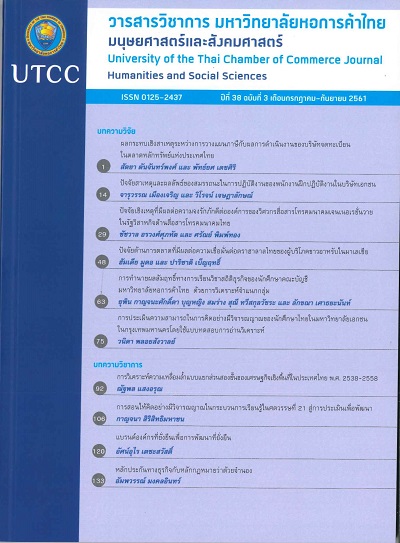Antecedents and Consequences of Work Competency of Practice Staff in Private Companies
Main Article Content
Abstract
The purposes of this research are to study the antecedents and consequences of work competency of practice staff in private companies. The sample group used for the study consisted of 400 personnel. Questionnaires were used as the tools for data collection, and methods of analysis included percentage, standard deviation, and the relationships between independent variables, Pearson’s correlation, and multiple regressions. The results showed that the antecedents affecting performance effectiveness, career advancement, work happiness, and work life balance. Outcome work competency affected performance effectiveness, knowledge, skills, self-concept, traits, and motive. Finally, the implications of the findings and suggestions for future research are presented.
Article Details

This work is licensed under a Creative Commons Attribution-NonCommercial-NoDerivatives 4.0 International License.
ลิขสิทธิ์ของบทความ
ผลงานที่ได้รับการตีพิมพ์ถือเป็นลิขสิทธิ์ของมหาวิทยาลัยหอการค้าไทย ห้ามมิให้นำเนื้อหา ทัศนะ หรือข้อคิดเห็นใด ๆ ของผลงานไปทำซ้ำ ดัดแปลง หรือเผยแพร่ ไม่ว่าทั้งหมดหรือบางส่วนโดยไม่ได้รับอนุญาตเป็นลายลักษณ์อักษรจากมหาวิทยาลัยหอการค้าไทยก่อน
References
CP All Public Company Limited. (2018). About CP All. Retrieved January 11, 2018, from https://www.cpall.co.th/ Corporate/about-cp-all (in Thai).
Cronbach, J. L. (1990). Essentials of psychological testing (5th ed.). New York, NY: Harper and Row.
Diener, E. (2000). Subjective well-being: The science of happiness and a proposal for a national index. American Psychologist, 55(1), 34-43.
Domjan, M. (1996). The principles of learning and behavior. Belmont, CA: Thomson /Wadsworth.
Eakkawat, B., & Chalermwat, P. (2013). A study of factors affecting work performance competency of personnel in subdistrict administrative organizations in Prachuap Khiri Khan Province. Silpakorn Educational Research Journal, 5(1), 292-306. (in Thai).
Fiedler, F. E. (1967). A theory of leadership effectiveness. New York, NY: McGrawHill.
Herzberg, F., Mausner, B., & Snyderman, B. B. (1959). The motivation to work. New York, NY: John Wiley & Son.
Hinkle, D.E, William, W., & Stephen, G. J. (1998). Applied statistics for the behavior sciences (4th ed.). New York, NY: Houghton Mifflin.
Jintananont, S., & Sirikudta, S. (2014). Competency and hierarchy of needs related to working efficiency of employees of Krungthai Bank Public Company Limited in Ratchatewi district. Srinakharinwirot Business Journal (SBJ), 5(2), 61-77. (in Thai).
Likert, R. (1961). New patterns of management. New York, NY: McGraw-Hill.
Lovell, R. B. (1980). Adult learning. New York, NY: John Wiley & Son.
McClelland, D. C. (1999). Identifying competencies with behavioral-event interviews. Psychological Science, 9(5), 331-339. Retrieved from www.eiconsortium.org/ research/business_case_for_ei.htm.
Manion, J. (2003). Joy at work: Creating a positive workplace. Journal of Nursing Administration, 33(12), 652-659.
Maslow, A.H. (1970). Motivation and personality (2nd ed.). New York, NY: Harper & Row.
Mathis, R. L., & Jackson, J. H. (2008). Human resource management (12th ed.). South-Western, TX: Thomson.
Merrill, A.R., & Merrill, R.R. (2003). Life matter: Crating a dynamic balance of work, family, time and money. New York, NY: McGraw-Hall.
Muchinsky, P. M. (1993). Psychology applied to work: An introduction to industrial and organizational psychology (4thed.). Belmont, CA: Wadsworth.
Murphy, L.R. (1995). Managing job stress and employee assistance/human resource management partnership. Personnel Review, 24(1), 41-50.
Ninlapart, A., & Tiacharoen, S. (2013). Happiness of work and competencies of teachers under the Bangkok metropolitan administration in Bangphlad district office. Journal of Educational Administration, SilpakornUnversity, (4)1, 1-12. (in Thai).
Panyapiwat Institute of Management. (2018). Corporate university by CP All Plc. Retrieved January 11, 2018, from https://www.pim.ac.th/en/pages/cpall (in Thai).
Price, J.L. (1968). Organizational effectiveness: An inventory of propositions. Homewood, IL: Richard D Irwin.
Promsaart, U., Leelataweewud, U., Torugsa, S., & Kongsin, S. (2012). An empowerment of work influencing the job competency of registered nurses, private hospital, Bangkok metropolis. Journal of Public Health, 42(2), 92-102.
(in Thai).
Rothwell, W. J., & Kazans, H. C. (1992). Mastering the instructional design process. San Francisco, CA: Jossey-Bass.
Rovinelli, R. J., & Hambleton, R. K. (1977). On the use of content specialists in the assessmen of criterion-referenced test item validity. Dutch Journal of Educational Research, 2, 49-60.
Spencer, L. M., & Spencer, S. M. (1993). Competence at work: Models for superior performance. New York, NY: John Wiley & Sons.
Steers, R.M. (1977). Introduction to organization behavior (4thed.). New York, NY: Harper Collins.
Stevens, J. (1992). Applied multivariate statistics for the social science (2nd ed.). New York, NY: Harper and Row.
Suwansit, R., & Jadesadalug, V. (2014). Perceived organizational support in which affects performance effectiveness through personnel core competency of social security office. Veridian E-Journal, Slipakorn University, 8, 2217-2235.
(in Thai).
Tongsamsi, K., & Trichandhara, K. (2014). A conceptual framework of the factors affecting job competency in organizations. Journal of Management Sciences, 31(1), 169-187. (in Thai).
Warr, P. B. (2007). Work, happiness, and unhappiness. New York, NY: Lawrence Erlbaum.
Yamane, T. (1967). Statistics: An introductory analysis. New York, NY: Harper and Row.


